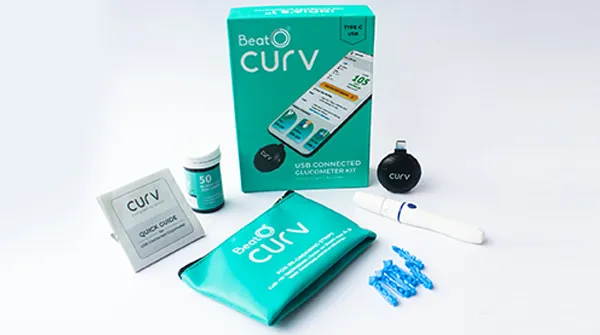Blood glucose monitoring system, called BGMs, is an acronym quite popular within the scientific and research community. On the other hand, people with diabetes call this portable device a “Glucometer”. Over the past few decades, BGMs have become integral to millions of individuals suffering from blood sugar upheavals. Glucometers have evolved into frontline warriors, monitoring diabetes daily and lowering the risks of associated illnesses.

For the uninitiated or those who are first-time users, blood glucose meters can be overwhelming to look at. The kit typically consists of the following components –
- The device has a large/small screen and several buttons
- Lancets
- A lancing pen/tool
- Glucometer strips
- Batteries and carry case (optional)
Interestingly, smartphone glucometers may have fewer or greater components than their traditional rivals, depending on the brand and technologies exploited by the manufacturer. Whichever device or brand you choose, glucometer accuracy is of paramount importance. Compromised or incorrect reading can be catastrophic, to say the least. If you have arrived this far, you obviously want to know more about blood glucose monitoring systems.

Ensure Consistent & Reliable Readings – A Guide
The Significance of Glucometer Accuracy
Although A1c clinical / lab tests are an important part of diabetes monitoring, regular check-ups at home with a traditional blood glucose meter or a CGM can provide significant insights. However, there is a catch. The readings from this device need to be highly accurate, which in turn helps understand the following –
- The foods that trigger glucose spikes
- Effect of stress and alcohol on diabetes
- The effect of medicines (manipulating dosage becomes easy)
- The reasons and frequency of hypoglycemia or hyperglycemia events
Understanding Factors That Affect Glucometer Accuracy
Following standard practices and adhering to general do’s and don’ts can go a long way in providing accurate readings. Remember, glucometer price is not the criteria. What is important is complying with the manufacturer’s instructions, procedures, and recommendations. Some of the other factors that affect glucometer accuracy include –
- The quality and coding of the device – The device is the heart and the soul of the diabetes control kit. It will provide precise readings if this same is made from quality components, embedded with the latest technologies, and coded scientifically.
- Calibration – Every new and even used glucometer must be calibrated before use. We will talk about this in the latter section.
- Test strips – Apart from the device, test strips are crucial in offering perfect results. Do not use incompatible, expired, soiled, or unbranded strips, which will provide conflicting readings.
- Batteries – Faulty, partially drained, dead, or incompatible batteries are also known to interfere with the functioning. This, in turn, affects the accuracy of the test results.
- Personal hygiene – Remember, extracting blood from soiled/oily fingers or hands which are heavily moisturised can affect the accuracy of your blood glucose reading. Make sure you wash your hands, dry them with a clean towel, and then initiate a test.
Choosing a Reliable Glucometer Brand
Choosing/buying a reliable glucometer machine need not be frustrating. Whether you buy from an offline store or an online e-commerce shop, read the product description / accompanying manual/technical literature. Compare the features of two or more glucometers. Check out the reviews. User comments provide impeccable insights, especially where performance and reliability are concerned. Remember, it is about affordability, consistency, accuracy, and sustainability. Talk to your healthcare professional or someone already using such a device. One of the online stores offering a wide range of brands is BeatO. This young start-up also offers innovative smartphone glucometers and connected monitoring devices. Check out their store today.
Regular Maintenance and Quality Control
Just like any other medical device, even glucometers demand care and attention. Regular maintenance not only offers accurate readings but also extends the life of the machine itself. However, the question is how often you should clean/check and initiate quality control tests. The most common period is “every fortnight”. Glucometer use tends to leave behind tell-tale marks and a host of impurities and dirt. Make sure you clean the device and the test area with gauze dipped in diluted alcohol solution. Also, make sure that you store the test strips in a cool, dry place. Lancets can easily get infected. Make appropriate arrangements for these pokers/needles.
As a user, you need to perform a control solution test. This quality assessment can tell you if your blood glucose meter and, of course, your test strip provide accurate results. Perform the test regularly. It becomes mandatory if you drop or use the device after a long period.
Calibrating Your Glucometer
A glucometer machine can either self-calibrate (automated) or require user intervention. You need to compare the calibration code with the inscription on the test strip bottle/container for the latter. Calibrating is necessary and should be initiated regularly, especially when opening a new test strip vial.
Read More: Glucometers: Transforming Fear into Confidence for Diabetes Management
Conclusion
Blood glucose meters are like a personal guard for people with diabetes. It safeguards the user from long-term complications associated with this disease. Choosing the right type and brand can go a long way in monitoring blood glucose levels hassle-free. However, glucometers demand attention and care like any scientific/medical device. Maintaining proper hygiene and initiating regular maintenance and quality control tests guarantees accurate results. Whether you opt for a traditional blood glucose meter or a Smartphone variant, make sure you read the manufacturer’s instructional booklet before calibrating the device/machine.
Disclaimer:The content of this article is compiled information from generic and public sources. It is in no way a substitute, suggestion, or advice for a qualified medical opinion. Always consult a specialist or your own doctor for more information. BeatoApp does not claim responsibility for this information .
Dr. Navneet Agarwal is an established and highly skilled Diabetology with over 25 years of experience in Diabetology & Obesity. He is well-regarded for his quality and patient-centered diabetes care. Also, keep track of your blood sugar levels with a Doctors’ approved smart glucometer and elevate your healthcare routine.




